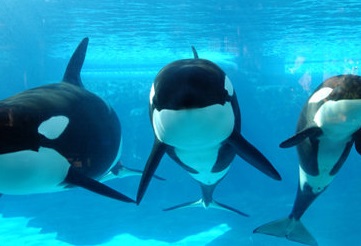Takara: Stifled Energy

By Christina Colvin
Smart and eager to learn, Takara loves new things: new toys, new activities, and learning new behaviors. She relishes the company of other whales, and often observes what they do in order to add fresh maneuvers to her repertoire. Takara’s appetite for novel experiences and intellectual challenges makes her an enthusiastic student of what other whales and SeaWorld trainers can teach her.
However, this same desire to learn means that the unchanging, repetitive environment of captivity is likely incredibly stifling for Takara. Her inquisitive personality and insatiable curiosity demand more than life in a tank can provide.
Early life

Takara with her mother, Kasatka.
For the first 12 years of her life, Takara lived with her mother, Kasatka, the long-time matriarch of the SeaWorld San Diego orcas. Takara and her mother shared a deep and close bond. In the wild, orca mothers and their female calves often spend about 15 years living together in the same family group, or pod. In 2004, when Takara was 12 years old, SeaWorld decided to ship her to a facility across the country. Takara was lifted from her tank and placed into the box of an 18-wheeler bound for Florida.
With Takara loaded like cargo onto the truck, Kasatka could no longer sense her daughter’s presence in the waters around her. So she began to emit what one scientist would later conclude to be a long-range vocalization. In other words, Kasatka was crying out to Takara. Her long-range calls – a pleading attempt to bring her daughter back to her side – continued long after Takara was gone.
The heart-wrenching separation of Takara and Kasatka testifies to the bonds shared between orca mothers and their calves; it also shows how the captivity industry prioritizes profits before the interests of whale families.
SeaWorld posted this video of one of Takara’s calves, Kamea, shortly after she was born in 2013. Her next (and last) calf, Kyara, was born in 2017 and died three months later. Kamea is still alive.
Takara’s last calf
Now over 20 years old, Takara lives at SeaWorld San Antonio, where she is the oldest killer whale and can be visually identified by the light brown birthmark on the white underside of her rostrum (roughly equivalent to a snout).
In 2017, Takara gave birth to Kyara, her fifth calf. Since SeaWorld had agreed, a year earlier, to bring an end to its captive orca breeding program, this made Kyara the last orca who would be born at any of their marine parks. Tragically, however, Kyara contracted pneumonia and passed away after only three months of life.
According to the Merck veterinary manual online, pneumonia is the leading cause of death in captive marine mammals. The manual states, “Pneumonia often can be considered the result of mismanagement, although even in carefully managed captive animals pneumonia-associated mortality is common.”
Beyond the call of duty
Even though Takara has endured tremendous heartbreak during her life in captivity, she still demonstrates an immense capacity to care for others. John Hargrove, a former trainer who worked extensively with Takara, remembers well a time that this killer whale went out of her way to help a human who could not help himself.
She slowly swam him to the side of the pool and placed him gently onto the side.
The incident took place when John and another trainer were working with Takara and another orca, Keet. They were preparing for a double waterwork maneuver in which John had to balance with one foot on Takara’s rostrum at the bottom of the pool while the other trainer was standing on another orca, Keet.
As Takara gathered speed, her rostrum shifted and John’s foot slipped out of position. Takara sensed something was wrong and tried to correct her speed and direction.
“As my foot slipped off at the surface,” John writes, “she had no way to stop, and she hit me with 5,000 pounds at 30 mph in my chest and ribs.”
But then, rather than abandon the scene of the accident, she began circling his barely mobile body to assess how badly he had been hurt.
According to John, the normally energetic Takara immediately became a patient, careful rescuer. After enabling him to grab onto her rostrum with his hands, she slowly swam him to the side of the pool and placed him gently onto the side. Her actions demonstrated a level of knowing and patience far beyond what any human had taught her.
Even after over two decades in captivity, Takara continues to yearn for opportunities to pursue her curiosity. What might life in a seaside sanctuary mean for her? Perhaps a world of new experiences to meet with enthusiasm and energy.